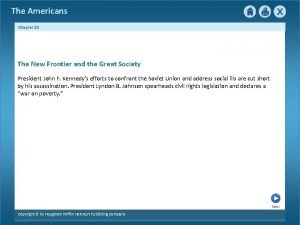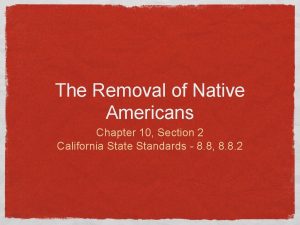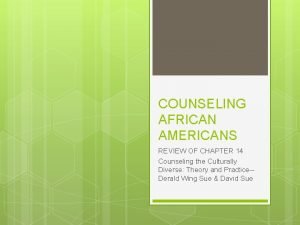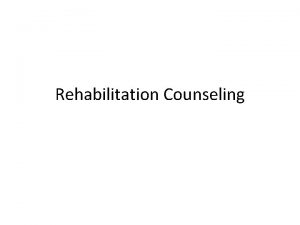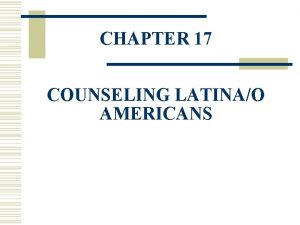CHAPTER 14 COUNSELING AFRICAN AMERICANS Statistics w African









- Slides: 9

CHAPTER 14 COUNSELING AFRICAN AMERICANS

Statistics w African Americans make up about 13% of the U. S. population. w Poverty rate is almost two times higher that of all households (23. 5 vs. 13%). w Of the African American males between the ages of 25 and 29, 12% are in prison compared to 1. 7% for White males. w Unemployment rates are double (16. 5 vs. 8. 5%). w Infant mortality rate is twice that of Whites and life span is 5 to 6 years shorter than for Whites. w Median wealth of Whites is 20 times that of African Americans. w About 38% of African American households are middle class versus 44% of all households.

African Americans w However, the African American community is becoming more diverse with respect to social class, education level, and political orientation. w Many African American households: n n are headed by women, embrace extended family networks, have strong religious orientations, and accept varied gender roles.

Educational Characteristics w The gap in educational attainment between African Americans and Whites is narrowing. w In 2009, over 90% of African Americans had completed or enrolled in high school. w High school graduation rates increased to 84%. w For African American males, 62% of 6 th to 10 th graders aspire to attend college. w African Americans are 2 to 5 times more likely to be suspended from school and receive harsher consequences than Whites. w School personnel hold stereotypes of African American parents as being neglectful and incompetent , whereas they are supportive and caring.

Spirituality and Religious Values w Many African Americans are very spiritual and find their church communities to be very supportive. w A sample of low-income African American children whose parents regularly attended church had fewer problems. w Church support systems can promote resilience against racial microaggressions.

Racism and Discrimination w Racism exists in subtle and overt forms. w Cultural mistrust is a reaction to being discriminated against. w “Healthy cultural paranoia” can serve as a coping strategy with respect to racism. w Colorism—differential treatment based on skin tone (lighter skin gets preferential treatment) impacts African Americans (e. g. , housing or employment opportunities). w Racial socialization is important as it can buffer the negative effects of racism. w Ignoring racial socialization leaves children vulnerable to anxiety when peers accuse others of “acting white. ”

Cultural Strengths w Protective factors include positive ethnic identity; familial, extended kin, and community support systems; flexible family roles; achievement orientation; and spiritual beliefs/practices (this last factor is associated with lower levels of binge drinking among African American adolescents). w Kinship support diminishes risks of internalizing or externalizing problem behaviors. w Despite racism, families instill positive self-esteem through role flexibility. w Behaviors such as assertiveness and varied gender roles are positive. w Pride in self-reliance, racial identity, and ability to handle challenges is positive for Black women.

Implications for Clinical Practice n n During the first session, it may be beneficial to bring up the reaction of the client to a counselor of a different ethnic background (e. g. , “Sometimes clients feel uncomfortable working with a counselor of a different race; would this be a problem for you? ”). If the clients are referred, determine their feelings about counseling and how it can be made useful for them. Identify the expectations and worldviews of the African American clients, find out what they believe counseling is, and explore their feelings about counseling. Establish an egalitarian relationship.

Implications for Clinical Practice n n n Determine whether and how the client has responded to discrimination and racism in both unhealthy and healthy ways. Also examine issues around racial identity (many clients at the preencounter stage will not believe that race is an important factor). Assess the positive assets of the client, such as family (including relatives and nonrelated friends), community resources, and the church. Determine the external factors that might be related to the presenting problem. Help the client define goals and appropriate means of attaining them. After therapeutic alliance has been formed, determine the interventions collaboratively.
 Introduction to statistics what is statistics
Introduction to statistics what is statistics The americans chapter 11
The americans chapter 11 Chapter 19 the americans
Chapter 19 the americans Chapter 18 america claims an empire
Chapter 18 america claims an empire Chapter 15 immigrants and urbanization
Chapter 15 immigrants and urbanization The americans chapter 10
The americans chapter 10 Chapter 28 section 2 the new frontier
Chapter 28 section 2 the new frontier The americans chapter 10
The americans chapter 10 What did americans underestimate in their eagerness for war
What did americans underestimate in their eagerness for war Coahuiltecan tattoos
Coahuiltecan tattoos






